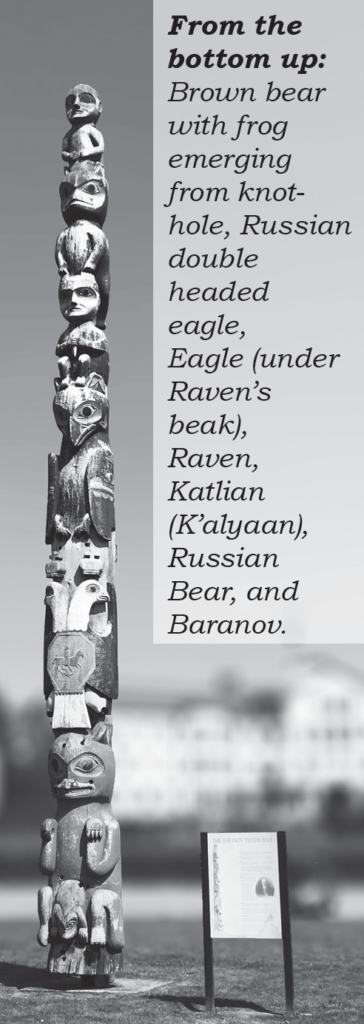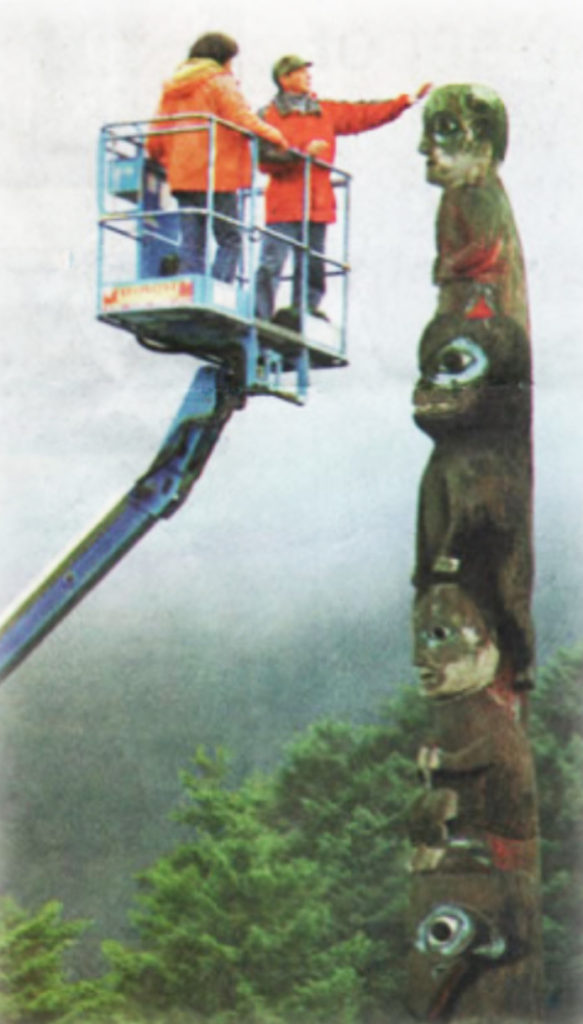Tommy Joseph: From Apprentice to Master Carver

Totem Pole in Totem Square.
The journey from apprentice to master, in any field, may not be a straight one. But as Tlingit master carver Tommy Joseph knows, the road – or the waterway – however winding it is, will surely be an interesting one.
Tommy’s journey started in Ketchikan, Alaska in 1964. That was when the Tlingit carver-to-be was born, as Naal xἁk’w, into the Ch’aak’/Gooch (Eagle/Wolf) moiety of the Kaagwaantaan (Wolf) clan.
On the water in downtown Sitka (Sheet’ka) is a peaceful square that offers a space for meditation or distanced gathering to Sitkans and visitors alike. The centerpiece of that square is a totem pole whose history is not entirely peaceful. Referred to as the “Baranof Totem Pole” – it tells part of the story of Kiks.ádi War Chief Ḵʼalyaan (Katlian) and Russian Territorial governor Alexander Baranov, whose forces engaged in Sheet’ka in 1802-1804.
Tommy Joseph’s intimate encounter with these two historic figures (and the other entities depicted on the pole) happened in 2011, when he worked on restoration of the pole.

George Benson’s original 1941 design. (provided by Tommy Joseph)
Tommy explains that the restoration, preservation, and cleaning process took him six to eight weeks in the summer of 2011. He was also involved in the 2010 condition assessment of the pole, alongside conservator Ron Sheetz. Ron is retired now, but Tommy shared a photo of the two of them together on a lift as they did the condition assessment.
2011’s restoration work was accomplished by Tommy with help from his then-friend, now-spouse Kristina Cranston. Tommy tells the story of their work.
“The first thing was to clean the entire pole – remove algae, lichen, moss. There were cracks in the pole that had been discovered when it was first taken down in 1964. Now, the development of cracks in wood over time is a normal process,” said Tommy, “but in 2011 we discovered something else – many of these cracks had been filled with wooden shims, which inadvertently had created more damage to the pole. Someone (involved with the pole) thought that they had been doing the right thing, but they had not – the shims swelled and caused the pole to crack more.”
Tommy’s path to knowledge of wood conservatorship started as an apprentice. “I apprenticed with Ron Sheetz and another guy, Al Levitan, of the National Park Service. Ron and Al traveled the country together as wood conservators. When I first met the guys, I started by just observing them doing their work – it was an informal-ish kind of apprenticeship in wood conservation.”
Part of the preservation process for a totem pole is a hollowing-out that is sometimes done, removing the added stuff. And part of what Tommy learned as a budding wood conservator is the science of rot and dry rot. “Katlian – that’s the 3rd figure down from the top of the pole – I had to carve a completely new hand and dagger for him, since the old hand and dagger had rotted away – the finishing nails that had been used to hold the shims had actually led to more rot.”
When asked about the original birth of the “Baranof Pole” Tommy tells the following tale:
“When George Benson designed the pole (in 1941) he was not available to do the carving (when the city elders wanted it done) since he was a fisherman and had to go out fishing. So, inquiries were made to Wrangell and the pole was ultimately carved in Wrangell.”

Tommy Joseph & Ron Sheetz on lift. (photo by James Poulson, provided by Tommy Joseph)
“Oddly,” says Tommy, “the design that George Benson had done was NOT what came back from Wrangell.” Notably, the figure of Alexander Baranof (at the top of the pole, placed there to represent an allegedly “stable” period) was significantly different from Benson’s design – the figure was not dressed, as in Benson’s drawing (he had been drawn by Benson wearing a woolen sweater and boots on his feet), but was naked! Out of some fleeting sense of propriety, a board had been fastened across the figure’s mid-section. Part of what Tommy did in 2011 was to remove the board and put clothes on the figure of Baranov.
Another piece of what Tommy did was to repaint the entire pole. He also replaced the lead cap on top of the pole. Nearly all the poles in Totem Park have lead caps (except for one which is copper). “Lead,” Tommy says, “is really nice and malleable to work with.”
Tommy also carves original totem poles, as well as wooden masks, boxes, spoons and canoes. The summer of 2021 will be his 30th year of being affiliated with the Sitka National Historical Park. He has been extensively involved with many of the poles in the park, both in restoration and in carving new original poles.
The carver’s current project (March 2021) is a brand new reproduction (3rd generation) of a Haida pole that depicts the Waasgo Lake Monster legend. Tommy says his daughter has been doing “all the painting on the Waasgo pole, which will “ultimately find a home somewhere along the trail through the park.”
Tommy can be seen most days working on the Waasgo pole at his roped-off workshop, located behind the Visitor Center of the Sitka National Historical Park. And his work can be seen all around Sitka.
